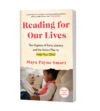By Karen Williams
Looking for a resource to help your child to get more out of reading at home?
Give FlipGrid a try. It’s an educational platform that allows educators to post a written or recorded prompt and learners to create short, shared videos in response. FlipGrid is used in PreK to PhD classrooms around the world as a popular tool for social learning.
FlipGrid isn’t just for teachers, though. As a parent, you are your child’s first and most important educator. You can use FlipGrid at home to help your child take a deeper dive into books. Just register for a free account, download the app, and create your “grid,” or learning community. Then you can post topics and prompts or use the app’s suggestions available in its Disco Library. FlipGrid integrates well with other parent reading resources with plug and play features, such as Wonderopolis, Epic!, MSN Kids, and more.
The combination of self-recording and sharing gives FlipGrid unique power to engage quiet introverts and social butterflies alike. Some children like the flexibility to record on their own time in their own way. Others enjoy addressing an imagined audience and bring a different persona or depth of response to their recordings than they do in everyday conversation.
Five Ways to use FlipGrid to Help Kids Get More Out of Books
Get creative with FlipGrid to spark a relationship with reading and to build up vocabulary, fluency, and comprehension skills.
Here are a few suggestions:
- Help your child create a book club or challenge with FlipGrid. Have them invite their friends or family members to join their book group “grid,” read a selected book, post a video review, and pose open-ended questions about the text. Watching and responding to each other’s videos makes reading a social experience for participants near and far. This activity uses FlipGrid’s video interaction capabilities to build lifelong habits of strong readers—reflecting on and discussing a book’s meaning with others.
- Encourage your child to log new vocabulary words by performing a skit depicting the word’s meaning and contrasting it with words with similar and/or opposite meanings. For example, to illustrate the word tranquil they might act out a quiet night at home watching the stars. Your child can compile a video “dictionary” to share with others or build a shared dictionary with friends on FlipGrid. This activity prompts deeper engagement and better retention than simply reciting definitions or using the word in a sentence.
- For a quiet-time activity, ask your child to record themselves reading aloud on FlipGrid. They can practice reading with expression and feeling and then get immediate feedback by listening to the recording, or re-record the same story multiple times to document improvement in fluency or expression. Children will love using props or other materials to introduce new characters, settings, and plot points; they can even make different “scenes” through use of multiple recordings in the same grid.
- Challenge your child to use their skills to make the book come alive! Maybe they can create a cooking demonstration video (in a real or play kitchen, depending on your child’s age) featuring a recipe inspired by the book. What about a tutorial explaining how to do something featured in the book? Can they record themselves making a DIY craft related to the story? (Check out this post for how to make DIY bookmarks with supplies you have at home.)
- Your child can explore a new topic inspired by the reading material—and invite further exploration from others. If the main character plays the guitar, your child could research the instrument, record a short video about what they’ve learned, and invite family to contribute videos of what they know about guitars. They could explore a hobby that piques interest or talk about an animal they’ve learned more about. The possibilities are endless!
Better yet, ask your child for ideas on how they can creatively use FlipGrid based on the story. You might be surprised with what they come up with!
The Bottom Line for Learners
FlipGrid is designed specifically to empower and amplify student voices. In education, student voice means students are able to express their perspectives, thoughts, and concerns about their educational experiences inside and outside of school. Student voice also means a learner’s cultural background and life experiences are acknowledged. These concepts are important, both at school and at home, because they help students feel heard and engaged with respect to the subject at hand, and therefore invested in their own learning. With FlipGrid, students can respond to reading not just by answering comprehension questions but by sharing their voice, refining their thoughts, and respecting the diverse voices of others.
Do you think you’ll give FlipGrid a try? Why or why not?


